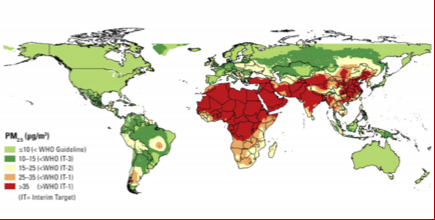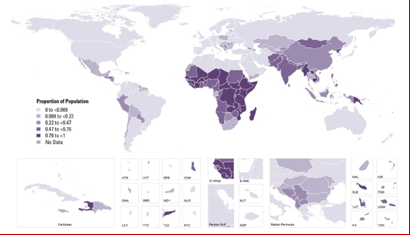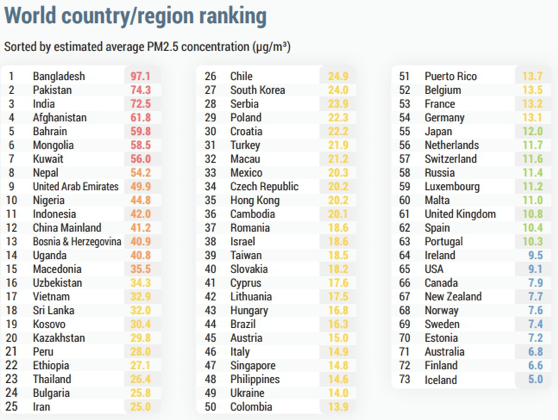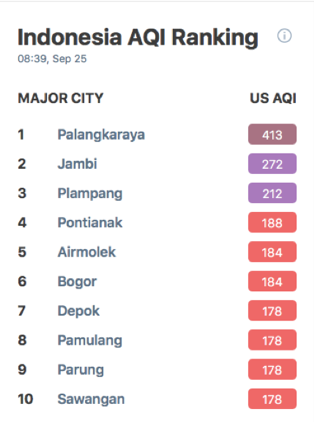
– JOIN THE CAMPAIGN –
Air pollution is not one’s problem, it is ours! Let’s join our hands to tackle this global issue by participating in our campaign through this link:
http://bit.ly/IDDRR2019CIMSA
Air pollution as the invisible killer!
Nowadays, air pollution is one of the biggest issues in the world. Air Pollution is a mixture of natural and man-made substances in the air we breathe. World Health Organizations (WHO) said that 92% of the world’s population lives in places where air quality exceeds the 2005 WHO Air Quality Guidelines. The guideline indicates air pollution by measuring particulate matter (PM), ozone (O3), nitrogen dioxide (NO2), and sulfur dioxide (SO2).
- Particulate Matter (PM)
Particulate Matter (PM) is more dangerous than other particles. It consists of a mixture of solid and liquid substances such as sulfate, nitrates, ammonia, sodium chloride, black carbon, mineral dust and water. PM is divided by two, PM10and PM2.5. PM10is a particular matter with a diameter 10 microns. It can enter the lung and stay at the alveolus. Meanwhile, PM2.5 is more harmful than PM10because it has diameter 2.5 microns (25.000 microns in an inch) that makes this particle can penetrate the lung barrier and enter the blood system. Based on WHO, the limit of PM10is20 μg/m3for annual mean and 50 μg/m3for 24-hour mean, meanwhile the limit of PM2.5 is 10 μg/m3for annual mean and 25 μg/m3for 24-hours mean
- Ozone
Ozone here means ozone at ground level. It is one of the types of photochemical smog. Photochemical smog is formed by the reaction between sunlight (ultraviolet light) and pollutants such as nitrogen oxides (NO2) and volatile organic compounds (VOCs) from vehicles, solvents and industry. Because of that ozone pollutants are more often found during sunny weather. Based on WHO, the limit of the ozone level is 100 μg/m3for 8-hours mean.
- Nitrogen Dioxide
Nitrogen dioxide is a nasty-smelling gas. Nitrogen dioxide can be in free form or it can react with ultraviolet light so that it produces photochemical smog. Other than that, the fact is NO2is the main source of nitrate aerosols, which form an important fraction of PM2.5.Nitrogen dioxide is dangerous because itinflames the lining of the lungs and it can reduce immunity to lung infections. Based on WHO, the limit of NO2is 40 μg/m3for annual mean and 200 μg/m3for 1-hour mean.
- Sulfur Dioxide
Sulfur dioxide (SO2) is an invisible gas with a sharp odor. It is a compound that easily react with other compounds to form harmful compounds. Furthermore, SO2can produce acid rain when it reacts with water, oxygen, and other chemicals in the atmosphere. Sulfur dioxide affects human health through many ways such as irritate the airways, eyes, and skin of humans. Based on WHO, the limit of SO2is 20 μg/m3for 24-hours mean and 500 μg/m310-minutes mean.
What does the hazardous compound above from?
Air pollution is typically separated into two categories: outdoor air pollution and indoor air pollution.
Outdoor air pollution involves exposures that take place outside of the built environment. Examples include:
- Fine particles produced by the burning of fossil fuels (i.e. the coal and petroleum used in energy production),
- Noxious gases (sulfur dioxide, nitrogen oxides, carbon monoxide, chemical vapors, etc.),
- Ground-level ozone (a reactive form of oxygen and a primary component of urban smog),
- Tobacco Smoke.
Indoor air pollutioninvolves exposures to particulates, carbon oxides, and other pollutants carried by indoor air or dust. Examples include
- Gases (carbon monoxide, radon, etc),
- Household products and chemicals,
- Building materials (asbestos, formaldehyde, lead, etc.),
- Outdoor indoor allergens (cockroach and mouse dropping, etc.),
- Tobacco smoke,
- Mold and pollen.
In some instances, outdoor air pollution can make its way indoors by way of open windows, doors, ventilation, etc.
Do not believe? Let’s check the data below!



How about air pollution in Indonesia?
Air pollution in Indonesia is getting worse everyday especially in Jakarta, Palangkaraya, Jambi, Kalimantan. According to Air Quality Index (AQI), Indonesia has become the 11th with the worst air quality in the world (PM2.5 concentration is 42 μg/m3).As we know, it is because the effect of forest fires, industrial factory, and transportation in Indonesia that getting worse.
Forest fires in Indonesia have been going on for a long time and getting worse this year. It’s because many factor such as the increasing of earth temperature. The increasing of earth temperature makes flammable materials such as tree leaves become flammable. Other than that, the issue that is often heard is that forest fires in Indonesia are caused by deforesration for oil palm plantations by irresponsible companies. Industrial factory and transportation are increasing every year. It makes air pollution is getting severe. Hazardous compound that we have discussed above become more and more in the air.


It affects us!
Air pollution has serious effects on the human health. Depending on the level of exposure and the type of pollutant inhaled, these effects can vary, ranging from simple symptoms like coughing and the irritation of the respiratory tract to acute conditions like asthma and chronic lung diseases.Skin problems and irritations can develop due to prolonged exposure to several air pollutants, and a variety of cancer forms may develop after inhaling air contaminants. Do not neglect potential diseases caused by air pollution. Air pollutants that have serious negative effects on the human health can be classified as toxic and non-toxic.
Other than that, based on National Institute of Enviromental Health Sciences, over the past 30 years, researchers have unearthed a wide array of health effects which are believed to be associated with air pollution exposure. Among them are respiratory diseases(including asthmaand changes in lung function), cardiovascular diseases, adverse pregnancy outcomes(such as preterm birth), and even death. In 2013, the World Health Organization concluded that outdoor air pollution is carcinogento humans. In Environmental Pollution Centers literature, skin problems and irritations can develop due to prolonged exposure to several air pollutants, and a variety of cancer forms may develop after inhaling air contaminants.
It’s becoming a disaster now!
Air pollutionis not only pollution but now it can be disaster. It is because air pollution can makes climate change. How does it relate? The answer is greenhouse effect. The greenhouse effect occurs when sunlight is trapped on the earth because it cannot be reflected back into space. This is because compounds such as carbon dioxide, methane and nitrous oxide will create a layer in the atmosphere that will hold out the sun’s rays from the earth. Because of that, the temperature of the earth will be increased. The increasing of earth temperature can cause some problems, such as prolonged drought, forest fires, and melting glaciers.
What we can do about it?
It is just a simple thing to reduce the risk of air pollution to become a disaster. It can start from ourselves, such as
- Use public transportation,
- Avoid burning leaves, trash, and other materials,
- Conserve energy,
- Support government policy
- Encourage people around us to reduce air pollution